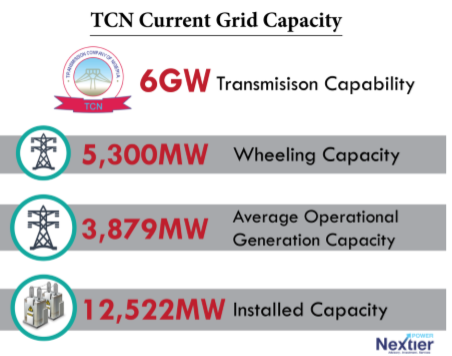Introduction
This article is a continuation of the Transmission Company of Nigeria (TCN) series on the possible solutions to the many challenges that plague the network (https://goo.gl/VWfsYq). Having discussed the possibility of privatisation in the previous article, this discusses regionalisation of the grid as a way of improving efficiency in transmission.
Current Grid Capacity
The transmission capability of TCN is estimated to be about 6GW. The transmission network, with entirely radial infrastructure, comprises of approximately 6,680km of 132kV lines, 7,780km of 132kV lines and 330/132kV substations among others, bringing the total capacity of the network to 7,500MW on paper.
However, the reality is different as current transmission wheeling capacity is at 5,300MW, significantly below the total capacity. Although transmission wheeling capacity (5,300MW) is higher than average operational generation capacity of 3,879MW, it is far below the total installed generation capacity of 12,522MW. This disparity, together with the radial infrastructure, is responsible for the inherent reliability issues as the radial lines do not give room for redundancies; hence, the need for regionalisation.
Regionalising the Grid
Regionalisation of the grid simply means splitting the national grid to serve different regions. A significant advantage of regionalised grid is the ability to better manage power supply and demand in each region and limit the blackout effect caused by any system collapse to that region.
Examples of Grids Around the World – In the United States of America, the Continental United States power transmission grid powers the entire mainland North America. It is made-up of five electric grid units that are linked by high voltage, direct current (HVDC) interconnections. These grids are;
• Eastern Interconnection : This is one of the two major electric grids in North America. It provides electricity to communities in central Canada (except Quebec), the Southern region of the US and to the foot of the Rocky Mountains. The Eastern Interconnection is linked to the Western and Texas Interconnections with six and two DC lines respectively and to Quebec Interconnection with four DC lines.
• Western Interconnection : The Western Interconnection is the other of the two major electric grids in North America. It stretches from Western Canada south to Baja California in Mexico, reaching eastward over the Rocky Mountains to the Great Plains.
• Texas Interconnection : The Texas Interconnection is one of the three minor power grids in North America as it has a relatively smaller coverage area. It services most of the state of Texas.
• Quebec Interconnection : This is also a minor electrical grid in North America covering all of the province of Quebec. The Quebec Interconnection links 18 systems in the US and Canada to one electric utility company. It is often considered to be part of the Eastern Interconnection because of its unique status.
• Alaska Interconnection : The Alaska Interconnection, the last of the three minor grids, is composed of two isolated grids.
This model has helped connect grid operators in the respective regions so they can share resources more easily and efficiently. Besides the benefits that accrue to efficient sharing of resources among operators, regionalisation comes with other benefits that could mean reduced operating cost and lower tariffs for final consumers. It should be noted that regionalised grids could easily accommodate the integration of renewable energy sources at a lower cost compared to the national grid. This translates not only into lower tariffs for consumers, but also promotes environmental sustainability. Finally, regionalised grids help tackle the issue of electricity storage as excess generated
electricity in one region can be traded to another region that has need for it.
Possible Models for Regionalisation
Nigeria operates a National grid that is responsible for providing electricity to the entire nation. This model has failed to perform efficiently as it is exposed to challenges that could be easily addressed by the regionalisation of the grid. With the existence of several utility companies servicing various jurisdictions in the country, the option of regional grid is feasible. In the short-run, the nation could start with two regional grids to service the northern and southern regions of the country. In this scenario, each distribution company would form a part of one of the two regional grids, depending on the jurisdiction they are currently responsible for and its location.
Another applicable model will be to regionalise the grid in line with the existing TCN structure i.e. splitting the national grid in a similar manner to the current TCN geographical division. With the TCN already split into 8 regions, splitting the national grid into these same regions stands to reduce the complexity involved in this transition as it would primarily involve the modification of existing infrastructure as opposed to a fresh start.
The models mentioned above would give room for the integration of renewable energy at a significantly lower cost. Also, each region would generate electricity from the best possible energy source in terms of availability.
The north would be expected to set the pace in renewable energy-solar and wind in particular. The southern region would have a good energy mix that comprises fossil fuel and renewable energy. The relatively high level of rainfall in this region would make it more economical to operate hydropower plants. Natural resources such
as gas and coal are abundant in the southern region therefore; operating fossil-fuel powered plants would also be more economical compared to the north.
Investment Opportunities
In order to attract investors in the abovementioned scenarios, the government would have to enter into a public-privatepartnership with credible investors. Given the financial implication of transitioning from a national grid to regional grids, the government would also require private sector funding. The only way to attract this funding and ensure investor confidence would be for the government to hold minority equity of about 20{1c02100822988c48c7b0a484ab61ac3d7f398d67c2f66594d88b2db33072d9d9}, limiting its role to supervisory and regulatory, and ensure the investors of cost-reflective tariff.
Sustainability
The sustainability of this model is heavily dependent on the energy policies in place. Without policies that create an enabling environment for its implementation, regionalisation would fail. Regions should be given autonomy when it comes to formulating policies in the industry as each region has characteristics that are unique to them. For example, regions with high quantity of fossil fuel deposits would require less-aggressive policies aimed at reducing greenhouse gas emission and vice versa. This approach has proven to be successful in several developed and emerging economies; hence, Nigeria should not be an exception.
Conclusion
It is recommended that the government carefully considers the options presented above (and more) as the government-run national grid has failed to perform efficiently over the years. With the generation capacity significantly higher than the transmission wheeling capacity, electricity is wasted in a country that is in dire need of it. The regionalised grid system would significantly reduce electricity waste as each grid’s transmission wheeling capacity would be proportional to the region’s average generation capacity. Issues like this and the fear of an increased tariff among others would be addressed by a regional grid model.
Author
Mazi Okoronkwo is a power sector analyst
Editor
Chinazo Ifeanyi-Nwaoha is a power sector analyst focused on the interplay of policy-practice and regulation







